lock BUICK LACROSSE 2007 Owner's Manual
[x] Cancel search | Manufacturer: BUICK, Model Year: 2007, Model line: LACROSSE, Model: BUICK LACROSSE 2007Pages: 512
Page 1 of 512
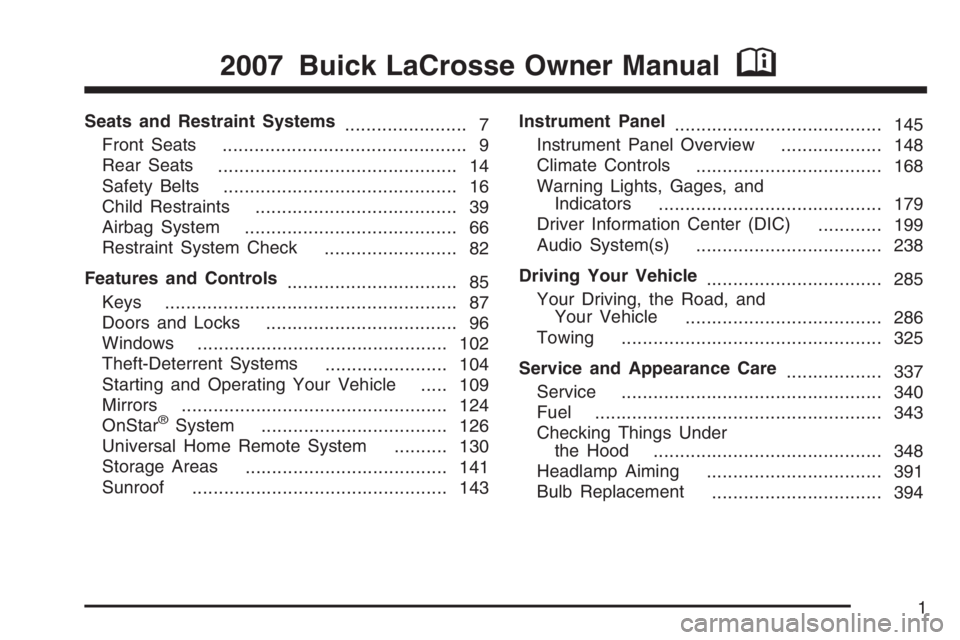
Seats and Restraint Systems
....................... 7
Front Seats
.............................................. 9
Rear Seats
............................................. 14
Safety Belts
............................................ 16
Child Restraints
...................................... 39
Airbag System
........................................ 66
Restraint System Check
......................... 82
Features and Controls
................................ 85
Keys
....................................................... 87
Doors and Locks
.................................... 96
Windows
............................................... 102
Theft-Deterrent Systems
....................... 104
Starting and Operating Your Vehicle
..... 109
Mirrors
.................................................. 124
OnStar
®System
................................... 126
Universal Home Remote System
.......... 130
Storage Areas
...................................... 141
Sunroof
................................................ 143Instrument Panel
....................................... 145
Instrument Panel Overview
................... 148
Climate Controls
................................... 168
Warning Lights, Gages, and
Indicators
.......................................... 179
Driver Information Center (DIC)
............ 199
Audio System(s)
................................... 238
Driving Your Vehicle
................................. 285
Your Driving, the Road, and
Your Vehicle
..................................... 286
Towing
................................................. 325
Service and Appearance Care
.................. 337
Service
................................................. 340
Fuel
...................................................... 343
Checking Things Under
the Hood
........................................... 348
Headlamp Aiming
................................. 391
Bulb Replacement
................................ 394
2007 Buick LaCrosse Owner ManualM
1
Page 11 of 512
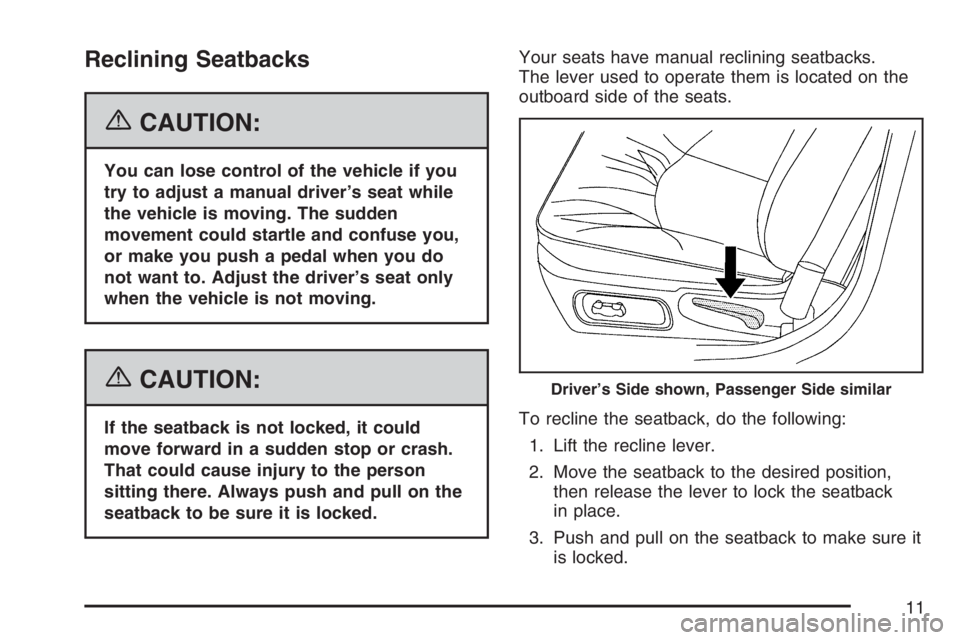
Reclining Seatbacks
{CAUTION:
You can lose control of the vehicle if you
try to adjust a manual driver’s seat while
the vehicle is moving. The sudden
movement could startle and confuse you,
or make you push a pedal when you do
not want to. Adjust the driver’s seat only
when the vehicle is not moving.
{CAUTION:
If the seatback is not locked, it could
move forward in a sudden stop or crash.
That could cause injury to the person
sitting there. Always push and pull on the
seatback to be sure it is locked.Your seats have manual reclining seatbacks.
The lever used to operate them is located on the
outboard side of the seats.
To recline the seatback, do the following:
1. Lift the recline lever.
2. Move the seatback to the desired position,
then release the lever to lock the seatback
in place.
3. Push and pull on the seatback to make sure it
is locked.
Driver’s Side shown, Passenger Side similar
11
Page 12 of 512
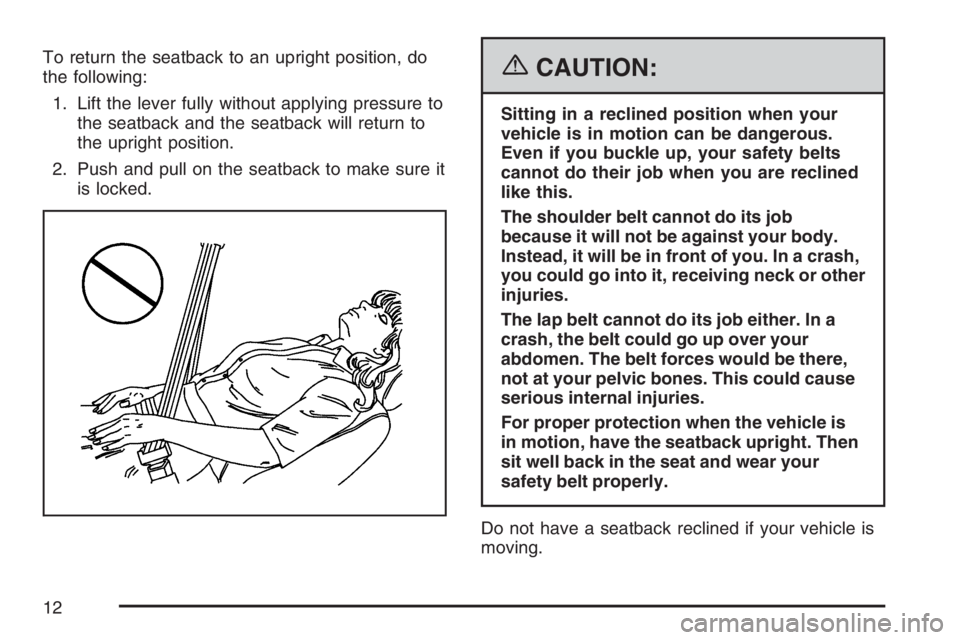
To return the seatback to an upright position, do
the following:
1. Lift the lever fully without applying pressure to
the seatback and the seatback will return to
the upright position.
2. Push and pull on the seatback to make sure it
is locked.{CAUTION:
Sitting in a reclined position when your
vehicle is in motion can be dangerous.
Even if you buckle up, your safety belts
cannot do their job when you are reclined
like this.
The shoulder belt cannot do its job
because it will not be against your body.
Instead, it will be in front of you. In a crash,
you could go into it, receiving neck or other
injuries.
The lap belt cannot do its job either. In a
crash, the belt could go up over your
abdomen. The belt forces would be there,
not at your pelvic bones. This could cause
serious internal injuries.
For proper protection when the vehicle is
in motion, have the seatback upright. Then
sit well back in the seat and wear your
safety belt properly.
Do not have a seatback reclined if your vehicle is
moving.
12
Page 15 of 512
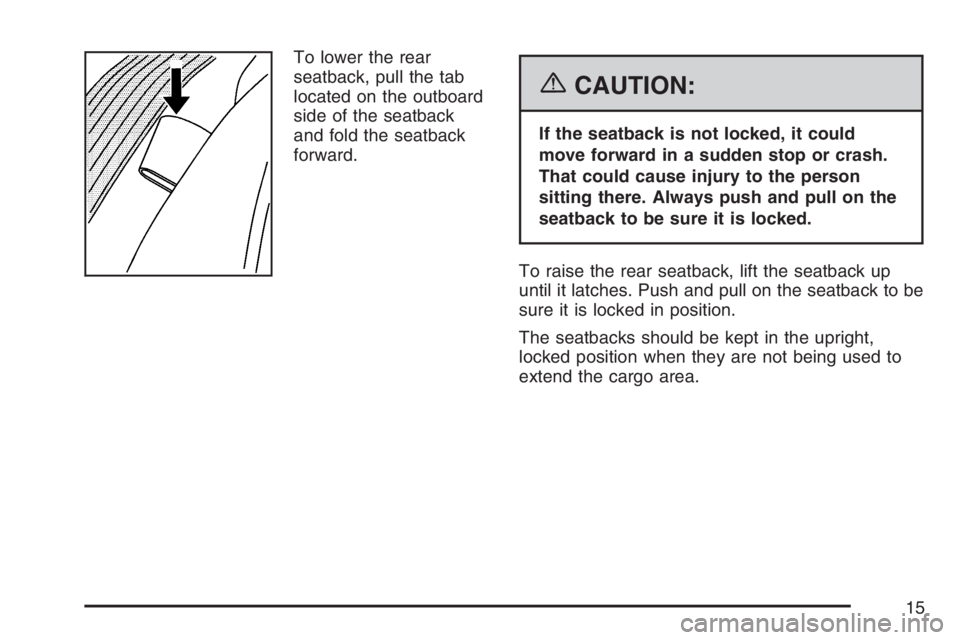
To lower the rear
seatback, pull the tab
located on the outboard
side of the seatback
and fold the seatback
forward.
{CAUTION:
If the seatback is not locked, it could
move forward in a sudden stop or crash.
That could cause injury to the person
sitting there. Always push and pull on the
seatback to be sure it is locked.
To raise the rear seatback, lift the seatback up
until it latches. Push and pull on the seatback to be
sure it is locked in position.
The seatbacks should be kept in the upright,
locked position when they are not being used to
extend the cargo area.
15
Page 22 of 512
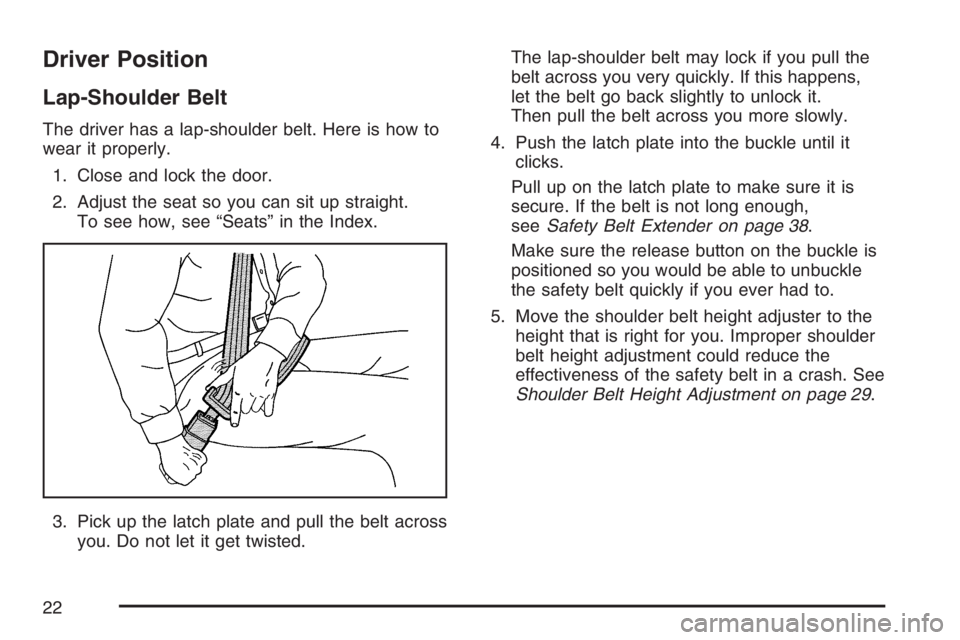
Driver Position
Lap-Shoulder Belt
The driver has a lap-shoulder belt. Here is how to
wear it properly.
1. Close and lock the door.
2. Adjust the seat so you can sit up straight.
To see how, see “Seats” in the Index.
3. Pick up the latch plate and pull the belt across
you. Do not let it get twisted.The lap-shoulder belt may lock if you pull the
belt across you very quickly. If this happens,
let the belt go back slightly to unlock it.
Then pull the belt across you more slowly.
4. Push the latch plate into the buckle until it
clicks.
Pull up on the latch plate to make sure it is
secure. If the belt is not long enough,
seeSafety Belt Extender on page 38.
Make sure the release button on the buckle is
positioned so you would be able to unbuckle
the safety belt quickly if you ever had to.
5. Move the shoulder belt height adjuster to the
height that is right for you. Improper shoulder
belt height adjustment could reduce the
effectiveness of the safety belt in a crash. See
Shoulder Belt Height Adjustment on page 29.
22
Page 23 of 512
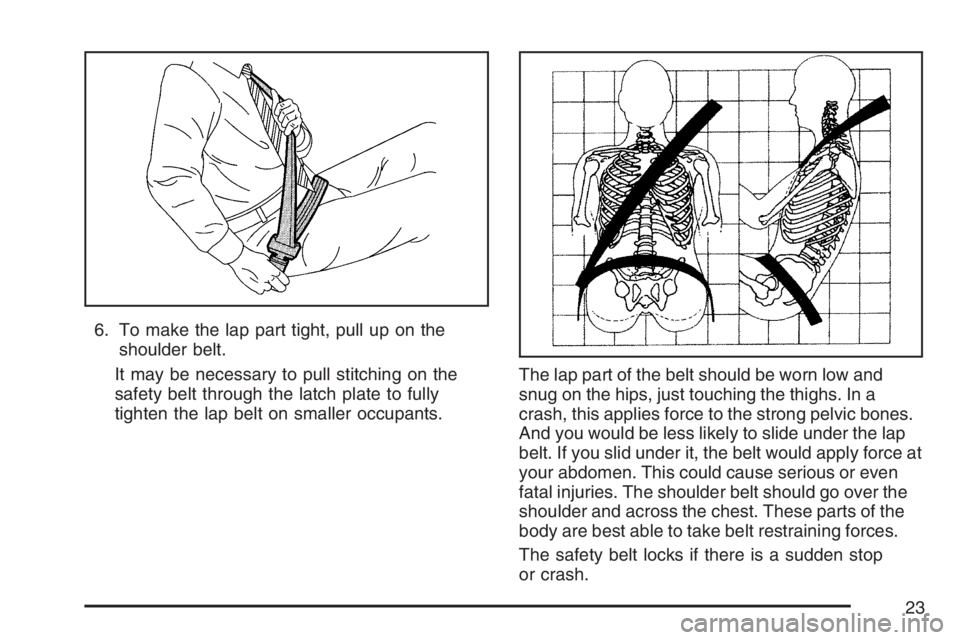
6. To make the lap part tight, pull up on the
shoulder belt.
It may be necessary to pull stitching on the
safety belt through the latch plate to fully
tighten the lap belt on smaller occupants.The lap part of the belt should be worn low and
snug on the hips, just touching the thighs. In a
crash, this applies force to the strong pelvic bones.
And you would be less likely to slide under the lap
belt. If you slid under it, the belt would apply force at
your abdomen. This could cause serious or even
fatal injuries. The shoulder belt should go over the
shoulder and across the chest. These parts of the
body are best able to take belt restraining forces.
The safety belt locks if there is a sudden stop
or crash.
23
Page 29 of 512
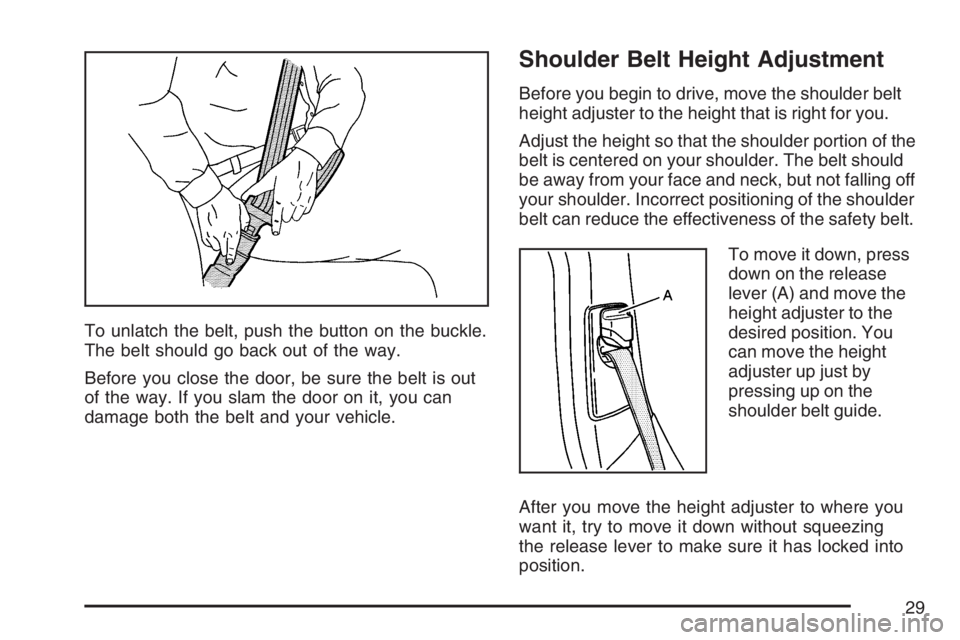
To unlatch the belt, push the button on the buckle.
The belt should go back out of the way.
Before you close the door, be sure the belt is out
of the way. If you slam the door on it, you can
damage both the belt and your vehicle.
Shoulder Belt Height Adjustment
Before you begin to drive, move the shoulder belt
height adjuster to the height that is right for you.
Adjust the height so that the shoulder portion of the
belt is centered on your shoulder. The belt should
be away from your face and neck, but not falling off
your shoulder. Incorrect positioning of the shoulder
belt can reduce the effectiveness of the safety belt.
To move it down, press
down on the release
lever (A) and move the
height adjuster to the
desired position. You
can move the height
adjuster up just by
pressing up on the
shoulder belt guide.
After you move the height adjuster to where you
want it, try to move it down without squeezing
the release lever to make sure it has locked into
position.
29
Page 30 of 512
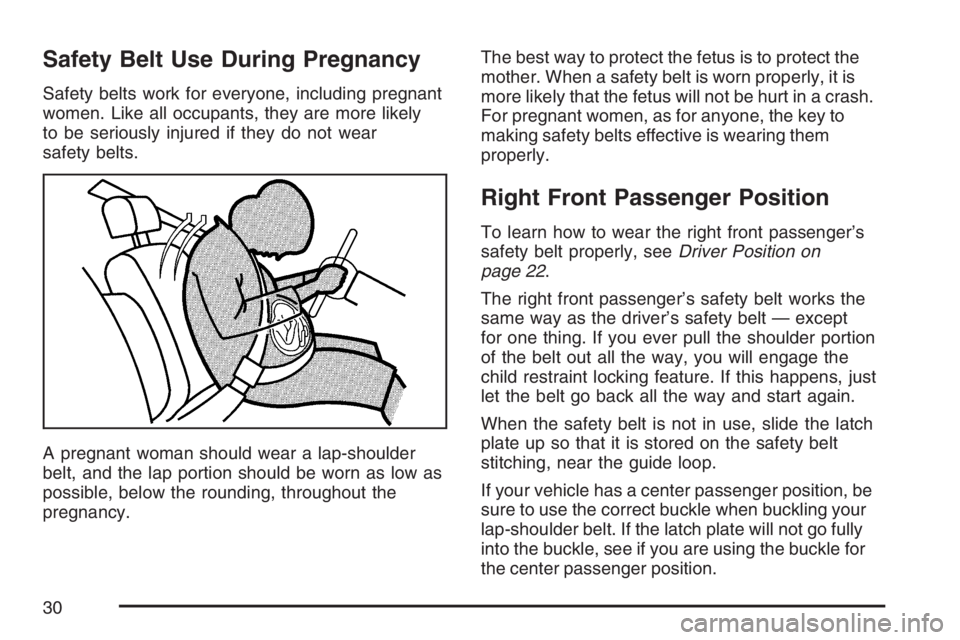
Safety Belt Use During Pregnancy
Safety belts work for everyone, including pregnant
women. Like all occupants, they are more likely
to be seriously injured if they do not wear
safety belts.
A pregnant woman should wear a lap-shoulder
belt, and the lap portion should be worn as low as
possible, below the rounding, throughout the
pregnancy.The best way to protect the fetus is to protect the
mother. When a safety belt is worn properly, it is
more likely that the fetus will not be hurt in a crash.
For pregnant women, as for anyone, the key to
making safety belts effective is wearing them
properly.
Right Front Passenger Position
To learn how to wear the right front passenger’s
safety belt properly, seeDriver Position on
page 22.
The right front passenger’s safety belt works the
same way as the driver’s safety belt — except
for one thing. If you ever pull the shoulder portion
of the belt out all the way, you will engage the
child restraint locking feature. If this happens, just
let the belt go back all the way and start again.
When the safety belt is not in use, slide the latch
plate up so that it is stored on the safety belt
stitching, near the guide loop.
If your vehicle has a center passenger position, be
sure to use the correct buckle when buckling your
lap-shoulder belt. If the latch plate will not go fully
into the buckle, see if you are using the buckle for
the center passenger position.
30
Page 32 of 512
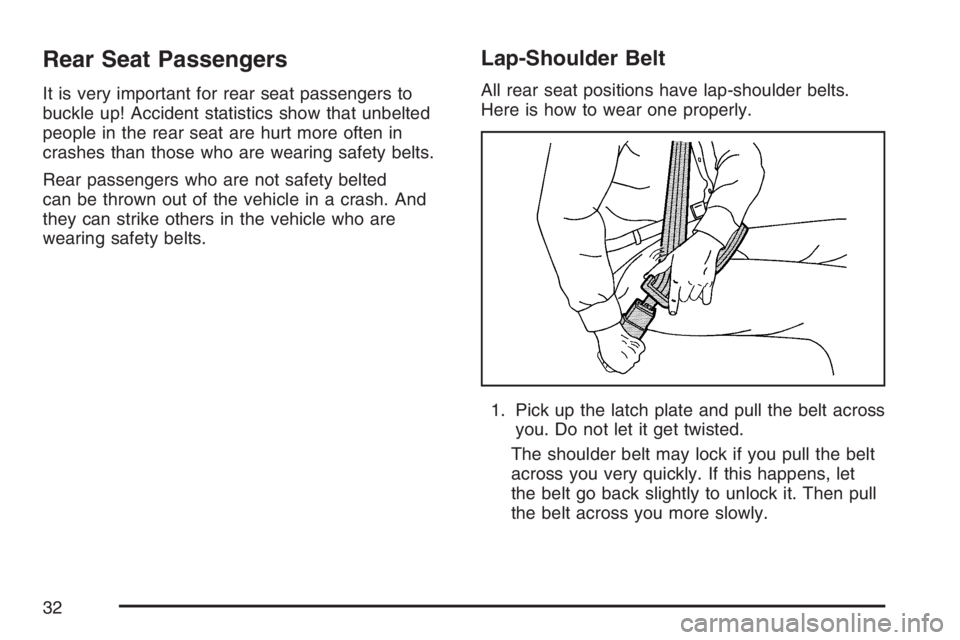
Rear Seat Passengers
It is very important for rear seat passengers to
buckle up! Accident statistics show that unbelted
people in the rear seat are hurt more often in
crashes than those who are wearing safety belts.
Rear passengers who are not safety belted
can be thrown out of the vehicle in a crash. And
they can strike others in the vehicle who are
wearing safety belts.
Lap-Shoulder Belt
All rear seat positions have lap-shoulder belts.
Here is how to wear one properly.
1. Pick up the latch plate and pull the belt across
you. Do not let it get twisted.
The shoulder belt may lock if you pull the belt
across you very quickly. If this happens, let
the belt go back slightly to unlock it. Then pull
the belt across you more slowly.
32
Page 33 of 512
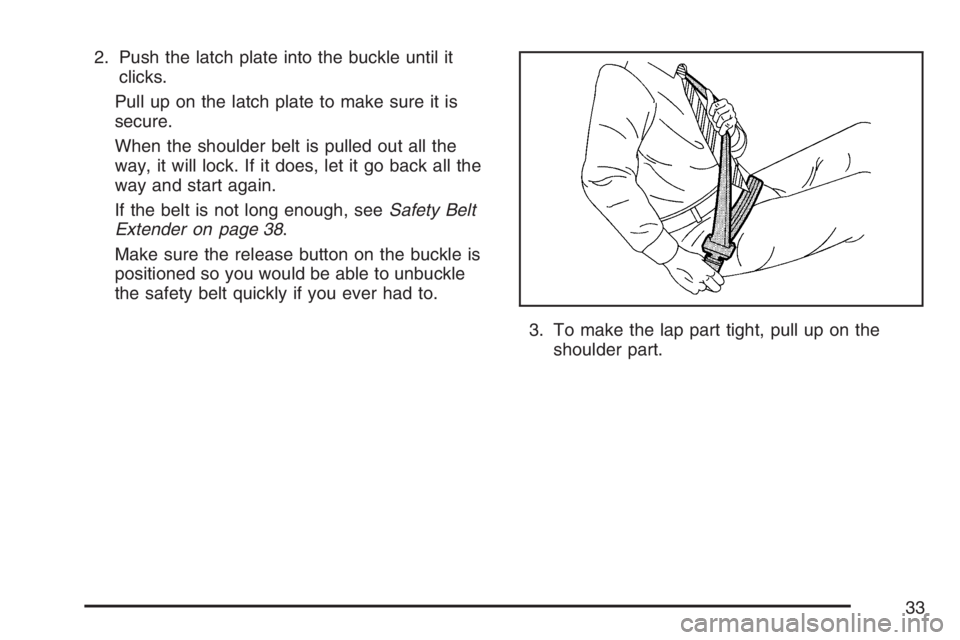
2. Push the latch plate into the buckle until it
clicks.
Pull up on the latch plate to make sure it is
secure.
When the shoulder belt is pulled out all the
way, it will lock. If it does, let it go back all the
way and start again.
If the belt is not long enough, seeSafety Belt
Extender on page 38.
Make sure the release button on the buckle is
positioned so you would be able to unbuckle
the safety belt quickly if you ever had to.
3. To make the lap part tight, pull up on the
shoulder part.
33